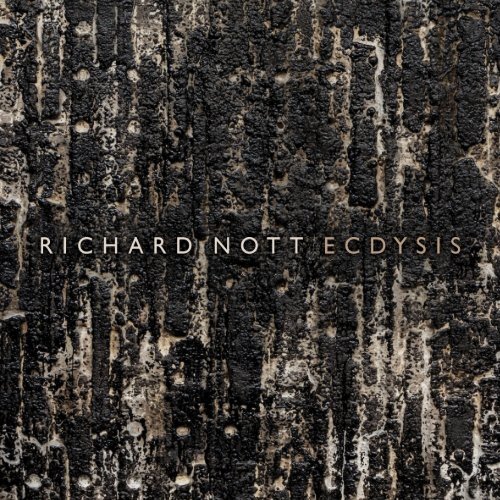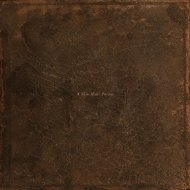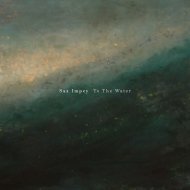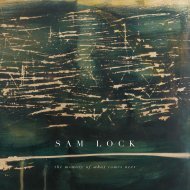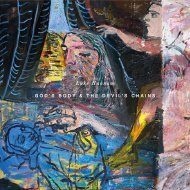Richard Nott 'Ecdysis'
Online publication for the solo exhibition 'Ecdysis' by Richard Nott at Anima-Mundi, St. Ives
Online publication for the solo exhibition 'Ecdysis' by Richard Nott at Anima-Mundi, St. Ives
You also want an ePaper? Increase the reach of your titles
YUMPU automatically turns print PDFs into web optimized ePapers that Google loves.
R I C H A R D N O T T E C D Y S I S
In recent years much of <strong>Richard</strong> <strong>Nott</strong>’s work has<br />
assumed a status that is as close to that of sculpture<br />
as it is to painting. The change often appears dramatic<br />
when compared to the ar tist’s earlier work, for some<br />
of his paintings now protrude from the wall in much<br />
deeper relief, their textured surfaces teeming with<br />
organic incident. This development was first seen<br />
to powerful effect in his last show at Anima-Mundi,<br />
2014’s ‘Histolysis’, and continues here in series of new<br />
works that are equally remarkable. It in fact forms a<br />
natural progression, given that <strong>Nott</strong> initially trained<br />
as a sculptor. He graduated in 1982 at a time when<br />
what came to be labelled New British Sculpture was<br />
pre-eminent, its practitioners – amongst them Bill<br />
Woodrow and Tony Cragg – making work from a<br />
catholic range of stuff encompassing urban detritus<br />
and other easily sourced materials. Both as a student<br />
and in the early stages of his career, <strong>Nott</strong>’s work<br />
was influenced by such approaches as much as by<br />
pragmatic economic necessity. He established an<br />
aesthetic sensibility based upon the deployment of<br />
cer tain materials, finding what he needed in what were<br />
to become constant components of his ar t: amongst<br />
them emulsion paint, resin, and bitumen.<br />
Crucially, all of <strong>Nott</strong>’s work is anchored in a foundational<br />
geometr y of strict horizontals and ver ticals; a structural<br />
basis he describes as adhering to the same principles<br />
as those involved in making a chair or a building.<br />
He works in series, moving from one piece to the<br />
other, forming within them interrelationships of mark,<br />
texture and tone, and always allowing for chance and<br />
serendipity as he prompts each towards some kind<br />
of individual and collective resolution. Many of his<br />
processes are intensely physical: the list of methods<br />
employed includes pouring, wiping, sponging, blotting,<br />
dragging, scraping, gouging, sanding, burning and<br />
peeling. The ar tist describes lots of reaction between<br />
the oiliness of bitumen and the water-based paints he<br />
utilises: these chemical reactions are fundamental to<br />
the work and its effects. He often uses a blowtorch on<br />
his paintings, scorching or setting light to their surfaces,<br />
sometimes flooding them with water, occasionally<br />
putting them out in the open for a time to contend<br />
with the elements. The work is rooted in oppositional<br />
forces: <strong>Nott</strong> describes his studio as the setting of<br />
‘a small war’, in which he under takes protracted<br />
battle with the tensions between control and chaos,<br />
structure and flux, subsumation and exhumation. Much<br />
of his time is spent in both applying and then removing<br />
paint, allowing for residual glimpses and traces of what<br />
lies beneath to come for th. Process and meaning are<br />
inextricable in <strong>Nott</strong>’s work. In discussion he often uses<br />
the word ‘histor y’, in reference to the accretion of time<br />
within the layers of his paintings. He makes an analogy<br />
of digging into the ear th; of how as one digs deeper it<br />
becomes blacker, and of how in his work he aims for<br />
its converse, a form of archaeological retrieval, or the<br />
gradual achievement of equipoise in which ‘things go<br />
from dark to light.’ Central is the idea of experience
and energy accumulated and contained within matter,<br />
both literally and metaphorically. In all of this the ar tist<br />
is keen to stress the fundamentally abstract nature of<br />
his work, and concerned to promote readings that are<br />
intuitive and allusive rather than literal.<br />
The title of this show, ‘Ecdysis’ 1 has both personal<br />
meaning for the ar tist whilst relating also to the<br />
largest works here, ‘Baetylus 1-3’, three imposing and<br />
blackly oleaginous square panels, each of them pretty<br />
much a man’s height. The paintings were worked on<br />
intermittently over a four-year period, during which<br />
they remained in constant material flux. One of the<br />
early stages of development involved laying down<br />
resin, which was then burnt and subsequently scraped<br />
off in strips like flayed flesh. Later this debris was<br />
glued back on, in thick strips and shards pressed<br />
onto the surface, where they were then subjected to<br />
fur ther treatment; gouged or burnt away so that their<br />
edges fused with bituminous residues and the greys<br />
of the underlying substrate. The resultant paintings<br />
are immensely tactile, somehow both primeval<br />
and sensual.<br />
In contrast to what is often a tor turous and lengthy<br />
process, working on paper allows <strong>Nott</strong> to make<br />
changes at a faster pace, to be less precious and more<br />
open to chance. A series of these smaller paintings<br />
usually begins with him stretching around thir ty sheets<br />
of paper. In common with all of his work, he first<br />
imposes an underlying structure, by scoring a grid<br />
into each sheet with a knife or the edge of a metal<br />
tool, sometimes allowing its spacing to be asymmetric,<br />
whilst making others as regular as a sheet of graph<br />
paper. Across this structural armature <strong>Nott</strong> drags<br />
swathes of emulsion, forming unpredictable smears and<br />
blockages as it catches within the grid’s indentations.<br />
Later the grid might be re-established, redrawn or<br />
par tially revealed by lightly sanding back the surface,<br />
and perhaps then existing only as a faint shadow, as<br />
though ghosted. As with his larger works, the ar tist<br />
often sets fire to the works on paper, the flame of<br />
the blowtorch ‘pitting the surface’ and ‘releasing what<br />
lies beneath’. He tends to keep them in the studio for<br />
some time, a kind of incubation period during which<br />
they might be subjected to accidental scuffs and stray<br />
spatters, before then finally being reassessed and<br />
resuscitated, ‘brought back to preciousness’. The linear<br />
structuring of <strong>Nott</strong>’s paintings on paper suggests pages<br />
of fragmentar y eroded text. They invoke something<br />
of the transience of memor y and time, and the<br />
fundamental role of language; retained, remembered,<br />
hidden or forgotten. They seem also about a yet more<br />
abstract language, one that is related to the spiritual in<br />
man and nature. There is a small white-on-white work<br />
on paper here, ‘Codex 1’, its delicate relief akin to<br />
Braille awaiting human touch. Others contain hundreds<br />
of tiny spore-like marks, some of them par tially<br />
washed away, whilst others appear as though rusted<br />
or corroded. All of the smaller paintings act in subtle<br />
1
counterpoint to the ostensibly greater drama of<br />
the ar tist’s more substantial panel paintings. Of the<br />
latter, shown here are a series of eight white reliefs<br />
entitled ‘Ecdysis 1-8’, along with three substantially<br />
larger ones in grey, ‘Eolith 1-3’, and ‘Ecdysial 1 and<br />
2’ that are larger still, all of their surfaces claggy and<br />
deeply encrusted. Like ever ything <strong>Nott</strong> produces, they<br />
result from what he describes as a ‘transformation’ of<br />
material, a brand of alchemical ar tifice here involving<br />
repetitive excavation and accumulation. The greys<br />
appear volcanic; coagulated and pockmarked, they are<br />
inflected here and there with a carboniferous sheen,<br />
whilst the whites are matt and bone-like, the delicacy<br />
of their edges frangible in appearance. A subtle play<br />
of light across these paintings gently activates their<br />
intricacies and emphasises their powerfully sensor y<br />
nature: touch is fundamental in all of <strong>Nott</strong>’s work.<br />
<strong>Nott</strong> utilises a limited palette, of what might be<br />
defined ‘non-colour’, formed from whites and greys<br />
mixed from emulsion paints, with blacks, browns and<br />
ochres from various consistencies of bitumen thinned<br />
with white spirit. Within these limits, the ar tist carefully<br />
mediates hue and tone, summoning a multiplicity of<br />
effects of mood and atmosphere from pale yellow<br />
infusions and ear th tones, his whites, greys and blacks<br />
suggesting the impalpability of light, smoke or mist.<br />
He is fully conversant with the power of restraint.<br />
Amongst his pantheon of greatly admired painters<br />
are the minimalists Agnes Mar tin and Rober t Ryman,<br />
and he has also cited Giorgio Morandi as an ar tist<br />
who achieved poetic resonance within the steadfast<br />
limitations of his still life subjects and restrained<br />
tonal palette.<br />
Restraint extends also to <strong>Nott</strong>’s titles, each painting<br />
and drawing identified with just one carefully selected<br />
word, words that often evoke metamorphosis and<br />
transformation of the physical or spiritual in land and<br />
body. Questioned about the metaphorical aspect of his<br />
work <strong>Nott</strong> refers to the inherent vulnerability of its<br />
materials and its immersive qualities, through which it<br />
derives its contemplative and meditative nature. Out<br />
of the highly physical processes he enacts through<br />
often-intense struggle, gradually and by stealth he<br />
achieves a form of agreement with the work, a point<br />
at which he recognises something of himself in it, and<br />
in which stasis and quietude prevail.<br />
Dr Ian Massey, 2017<br />
Dr Ian Massey is an ar t historian, writer and curator.<br />
His publications include major monographs on the<br />
ar tists Patrick Procktor and Keith Vaughan. He is<br />
currently writing a book about the St. Ives sculptor<br />
John Milne.<br />
1 From Collins dictionar y : ‘Ecdysis’ is the process of<br />
shedding the old skin in reptiles or the outer cuticle in<br />
insects and other ar thropods.<br />
2
4
EOLITH 1<br />
mixed media on panel . 90 x 90 x 12 cm<br />
5
EOLITH 2<br />
mixed media on panel . 90 x 90 x 12 cm<br />
6
7
8
EOLITH 3<br />
mixed media on panel . 90 x 90 x 12 cm<br />
9
ECDYSIS 1<br />
mixed media on panel . 60 x 60 x 12 cm<br />
10
11
12
ECDYSIS 2<br />
mixed media on panel . 60 x 60 x 12 cm<br />
13
ECDYSIS 3<br />
mixed media on panel . 60 x 60 x 12 cm<br />
14
15
16
ECDYSIS 4<br />
mixed media on panel . 60 x 60 x 12 cm<br />
17
ECDYSIS 5<br />
mixed media on panel . 60 x 60 x 12 cm<br />
18
19
20
ECDYSIS 6<br />
mixed media on panel . 60 x 60 x 12 cm<br />
21
ECDYSIS 7<br />
mixed media on panel . 60 x 60 x 12 cm<br />
22
23
24
ECDYSIS 8<br />
mixed media on panel . 60 x 60 x 12 cm<br />
25
ECDYSISAL 1<br />
mixed media on panel . 125 x 130 x 20 cm<br />
26
27
28
ECDYSISAL 2<br />
mixed media on panel . 123 x 123 x 14 cm<br />
29
CODEX 1<br />
mixed media on paper . 67 x 67 cm<br />
30
CODEX 2<br />
mixed media on paper . 67 x 67 cm<br />
31
CODEX 3<br />
mixed media on paper . 67 x 67 cm<br />
32
CODEX 4<br />
mixed media on paper . 67 x 67 cm<br />
33
34
CODEX 5<br />
mixed media on paper . 67 x 67 cm<br />
35
BAETYLUS 1<br />
mixed media on panel . 184 x 184 cm<br />
36
37
38
BAETYLUS 2<br />
mixed media on panel . 184 x 184 cm<br />
39
BAETYLUS 3<br />
mixed media on panel . 184 x 184 cm<br />
40
41
40 42
STRIGOSE 1<br />
mixed media on paper . 80 x 80 cm<br />
41 43
STRIGOSE 2<br />
mixed media on paper . 80 x 80 cm<br />
44
STRIGOSE 3<br />
mixed media on paper . 80 x 80 cm<br />
45
STRIGOSE 4<br />
mixed media on paper . 80 x 80 cm<br />
46
STRIGOSE 5<br />
mixed media on paper . 80 x 80 cm<br />
47
Published by Anima-Mundi to coincide with the exhibition ‘Ecdysis’ by <strong>Richard</strong> <strong>Nott</strong><br />
All rights reserved. No part of this publication may be reproduced, stored in a retrieval system or transmitted in any form or<br />
by any means electronic, mechanical, photocopying, recording or otherwise without the prior permission of the publishers<br />
Artwork photography by Graham Gaunt<br />
Portrait photograph by Joseph Clarke<br />
Introductory essay © Dr Ian Massey 2017<br />
Street-an-Pol . St. Ives . Cornwall . Tel: 01736 793121 . Email: mail@anima-mundi.co.uk . www.anima-mundi.co.uk


